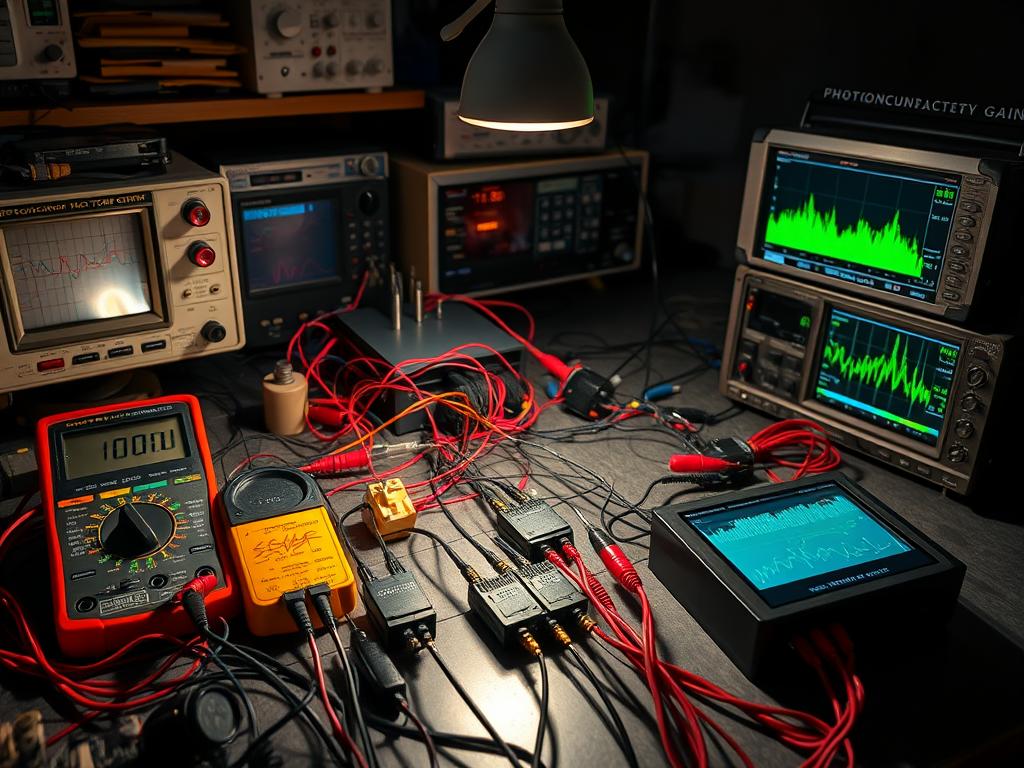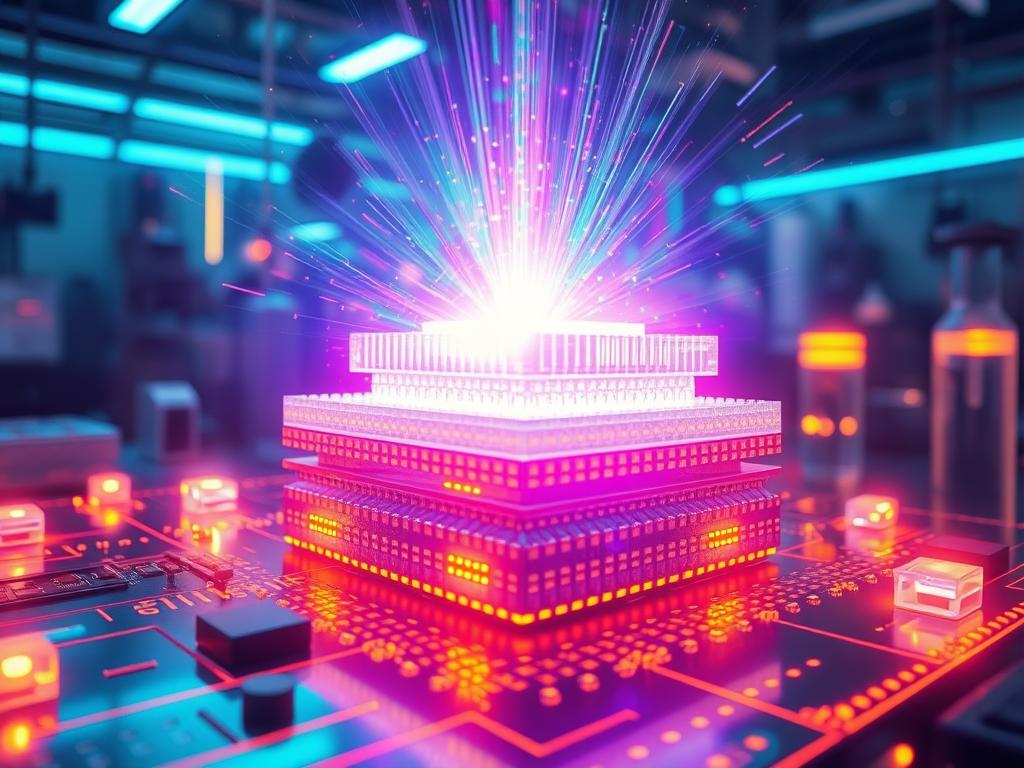Organic photodetectors can achieve external quantum efficiency (EQE) over 100%. This is possible through photoconductive gain. It’s a crucial process that connects light absorption to increased electrical output in transistors.
Photoconductive gain is key in modern optoelectronic devices. It enables high-gain detection and wider dynamic range compared to traditional photodiodes. This process is vital in imaging systems, advanced photodetectors, and phototransistors.
Photoconductive gain turns photons into electrical signals. This change is basic to semiconductor physics. It plays a crucial role in boosting transistor current.
The dual-gate device concept mixes photodiodes and phototransistors. It achieves high gain and linear photoresponse without external circuitry.
Recent progress in organic photodetectors (OPDs) has gained attention. These devices offer adjustable detection wavelengths and low-cost manufacturing. They’re also compatible with flexible, lightweight designs.
Understanding Photoconductive Gain
Photoconductive gain boosts light-sensitive devices’ performance. It amplifies absorbed photons’ effects, improving sensitivity in various applications. This process enhances the capabilities of many optical technologies.
Definition and Importance
Photoconductive gain amplifies photogenerated charge carriers in semiconductors. It’s the ratio of collected carriers to absorbed photons. This process can achieve external quantum efficiencies over 100%.
High-sensitivity photodetection and imaging applications rely on this phenomenon. It’s key to advancing many light-based technologies.
The Science Behind Photoconductive Gain
Photoconductive gain involves separating and moving photogenerated electron-hole pairs through conductive channels. Carrier lifetime, mobility, and applied electric fields influence this process.
Charge carrier multiplication enhances photoconductivity. This can happen through the avalanche effect or impact ionization. These mechanisms increase free carriers, boosting the material’s overall conductivity.
| Material Type | Examples | Characteristics |
|---|---|---|
| Intrinsic | Lead salt, Cadmium sulfide | Used in photoconductive detectors |
| Extrinsic | Doped Silicon, Germanium | Doped with As, Cu, Au, or In |
| BIB Detectors | Blocked Impurity Band | Uses additional intrinsic layer |
Quantum efficiency (QE) measures photoconductive gain efficiency. There are two main types: accumulative (QEacc) and apparent (QEapp) quantum efficiency.
QEacc is typically higher. Both approach unity under strong drift conditions. Doping can boost gain further.
“Photoconductive gain is a powerful tool for amplifying light signals, pushing the boundaries of what’s possible in photosensitive technologies.”
Mechanisms of Light Absorption in Semiconductors
Light absorption in semiconductors is key to photoconductive gain. This process depends on semiconductor properties and electron-hole pair generation. These mechanisms are vital for advancing Semiconductor Optoelectronics and boosting device performance.
Role of Semiconductor Materials
Semiconductor materials have different absorption coefficients and spectral responses. Silicon, group III-V compounds, and TMDs are popular in optoelectronic applications. WSe2 has high absorption coefficients, making it great for light-sensitive devices.
Dynamics of Electron-Hole Pair Generation
Photon absorption in semiconductors creates electron-hole pairs. This process depends on photon energy, material bandgap energy, and defect states. The efficiency of this conversion affects device performance.
Carrier generation rates change based on semiconductor properties and incident light. For silicon, visible light wavelengths range from 400-700 nm. The corresponding energies are 1.77 eV (red) to 3.1 eV (violet).
Typical photo currents range from 10-100 µA.
- Visible light wavelengths: 400-700 nm
- Corresponding energies: 1.77 eV (red) to 3.1 eV (violet)
- Typical photo currents: 10-100 µA
| Light Color | Wavelength (nm) | Energy (eV) | Absorption Depth in Silicon (µm) |
|---|---|---|---|
| Red | 700 | 1.77 | 3.3 |
| Green | 550 | 2.25 | 1.0 |
| Blue | 450 | 2.76 | 0.4 |
Absorption depth greatly affects light absorption efficiency in semiconductor devices. It impacts carrier generation and overall performance in optoelectronic applications. Understanding this helps improve device design and functionality.
Practical Applications of Photoconductive Gain
Photoconductive gain boosts the performance of many optoelectronic devices. It’s widely used in multiple applications, changing how we use light for tech advances. This phenomenon is key to several technological breakthroughs.
Use in Photodetectors
Photodetectors gain greatly from photoconductive gain. They can detect light with high sensitivity, surpassing 100% external quantum efficiency. CdS cells respond to light like human eyes, making them perfect for visible light detection.
CdSe photodetectors react faster, at about 10 ms. This is quicker than CdS, which takes around 100 ms to respond.
Impact on Solar Cells
Solar cells use photoconductive gain to improve charge collection and efficiency. This boost is vital for advancing renewable energy solutions. Sensitization techniques can greatly increase photoconductive gain in commercial devices.
Enhanced Performance in Transistors
Phototransistors use photoconductive gain to amplify photocurrents. This leads to better responsivity and detectivity, especially in imaging and communication. Some materials show negative photoconductivity, opening new paths for device design.
| Device | Application | Benefit of Photoconductive Gain |
|---|---|---|
| Photodetectors | Light sensing | High sensitivity, quantum efficiency >100% |
| Solar Cells | Energy harvesting | Improved charge collection, higher efficiency |
| Phototransistors | Imaging, communication | Amplified photocurrents, better responsivity |
Photoconductive gain proves useful in many optoelectronic devices. It drives innovation in imaging, communication, and energy harvesting. These applications show how versatile this phenomenon can be.
Measuring Photoconductive Gain
Gain measurement is crucial for understanding photoconductive device performance. It uses advanced techniques to quantify how devices convert light into electrical current. These methods help researchers improve device designs and advance photoconductive technology.
Techniques and Instruments
Photoresponse characterization uses various methods to assess device performance. Current-voltage measurements show how devices respond to light. Time-resolved photocurrent analysis captures charge carrier dynamics.
Spectral response tests evaluate device sensitivity across different wavelengths. Advanced instruments like spectrophotometers and lock-in amplifiers enable precise measurements.
DLOS at 297 K with a -5 V bias and 10 ms sampling time provides detailed insights. This method reveals important aspects of device behavior.

Interpreting Gain Measurements
Key parameters like responsivity and quantum efficiency are essential for interpreting results. Responsivity, measured in A/W, shows current produced per watt of light. It’s calculated using R = ΔI / (ϕ * q).
Quantum efficiency represents a device’s ability to generate electron-hole pairs from photons. High photoconductive gain, often over 50,000 at low voltages, indicates efficient charge multiplication.
β-Ga2O3 Schottky photodiodes have shown gains over 50 and responsivities exceeding 8 A/W. These numbers demonstrate the impressive capabilities of modern photoconductive devices.
| Parameter | Value | Significance |
|---|---|---|
| Photoconductive Gain | > 50,000 | High efficiency in charge multiplication |
| Responsivity | > 8 A/W | Strong current generation from incident light |
| Critical Electric Field | ~8 MV/cm | Threshold for optimal device operation |
Factors Affecting Photoconductive Gain
Photoconductive gain is affected by several key factors in semiconductor devices. These factors are crucial for improving device efficiency and performance. Understanding them helps optimize device functionality.
Material Properties
Semiconductor materials have intrinsic traits that impact photoconductive gain. Carrier Lifetime and Mobility determine charge carrier activity and movement speed. Silicon photoconductors work well for visible and near-infrared light detection.
Germanium is excellent for detecting near-infrared light. These properties help choose the right material for specific applications.
Temperature Influence
Temperature significantly affects photoconductive gain by impacting carrier dynamics. It can activate or deactivate Defect States within the semiconductor. Mid-infrared detectors often need cooling to 77 K for optimal performance.
Far-infrared detectors may require even lower temperatures, around 4 K. These temperature requirements ensure the best device functionality.
Light Intensity Effects
Incident light intensity directly impacts photoconductive gain. Higher intensities create more electron-hole pairs, which can lead to saturation. Some materials show negative photoconductivity, where light decreases conductivity due to carrier trapping.
A quantum-well photodetector study found that nonuniform photogeneration affects gain and noise. This can cause a 100% difference between photoconductive gain and excess current noise gain.
| Parameter | Value |
|---|---|
| Room Temperature Responsivity (940 nm) | >20 A/W |
| Dark Current Density (5 V reverse bias) | ~100 nA/cm² |
| Detectivity | ~10¹⁴ Jones |
| Minority Carrier Lifetime | >200 μs |
These factors together determine photoconductive device efficiency and sensitivity. They guide the design of advanced photosensors and detectors for various industries. Understanding these elements is key to creating better photoconductive devices.
Innovations in Photoconductive Gain Technology
Photoconductive gain technology is advancing rapidly. New semiconductors and 2D materials are changing photodetection and optoelectronics. These innovations are reshaping the field’s landscape.
Recent Advancements in Materials
Research shows promise in 2D materials like graphene for photodetection. These materials have high carrier mobilities and broad spectral coverage. Some photodetectors using these materials achieve bandwidths over 60 GHz with high gains.
Silicon-based CMOS photodetectors lead the market due to low cost and integration ease. III-V InGaAs and HgCdTe systems dominate infrared detection. However, they are expensive to manufacture, as noted in this study.
2D materials may soon disrupt the infrared detector market. They offer new possibilities for advanced photodetection systems.

Integration with Nanotechnology
Combining photoconductive gain technology with nanostructures yields promising results. Hybrid devices with quantum dots and nanowires show better light absorption. They also improve carrier transport.
These nanostructures offer unique advantages in light-matter interactions at the nanoscale. High electron mobility transistors (HEMTs) have shown device frequencies above 100 GHz.
Integrating nanostructures with new semiconductors creates next-gen photodetectors. These devices boast unprecedented performance metrics.
| Material | Advantages | Challenges |
|---|---|---|
| 2D Materials | High mobility, broad spectral coverage | Manufacturing readiness |
| Silicon CMOS | Low cost, high integration | Limited spectral range |
| III-V Compounds | Extended infrared detection | High cost, integration issues |
Researchers continue to explore innovative materials and nanostructures. The future of photoconductive gain technology looks promising. It may lead to transformative applications across various industries.
Industry Impacts of Enhanced Photoconductive Gain
Enhanced photoconductive gain is changing industries and pushing tech forward. It’s improving communication, power generation, and device interactions. This breakthrough affects many sectors, creating new possibilities.
Electronics and Telecommunications
Better photoconductive gain boosts data transmission speed and efficiency. Recent studies show that ZnO nanowires greatly improve UV detection. This discovery helps create more sensitive optical communication systems.
Renewable Energy Solutions
Enhanced photoconductive gain makes solar cells more efficient. CdTe quantum dots with 1.5 eV band gap energy improve ZnO nanowires’ UV detection. This could lead to better solar panels and sustainable energy options.
Consumer Electronics Trends
Imaging sensors in smartphones and cameras are getting better. At room temperature, responsivity at 940 nm exceeds 20 A/W. This means improved low-light performance and higher quality images.
IoT devices are becoming more sensitive and efficient. Their detectivity reaches ∼1014 Jones, with External Quantum Efficiency (EQE) over 100%. This opens new possibilities for smart homes and industry.
| Parameter | Value | Impact |
|---|---|---|
| Room Temperature Responsivity | >20 A/W at 940 nm | Improved sensitivity in imaging sensors |
| Dark Current Density | ∼100 nA/cm2 at 5 V reverse bias | Lower noise in electronic devices |
| Detectivity | ∼1014 Jones | Enhanced light detection in IoT devices |
| External Quantum Efficiency (EQE) | >100% | Higher efficiency in solar cells |
These improvements are happening now, not just in theory. They’re driving real-world changes in many industries. As research continues, we’ll see even more amazing uses for enhanced photoconductive gain.
Future Trends and Research Directions
Photoconductive gain is advancing rapidly. Researchers are developing more efficient and versatile devices. Let’s explore emerging technologies and potential breakthroughs in this field.
Emerging Technologies
Quantum photodetectors offer ultra-high sensitivity for light detection. They use quantum mechanics principles to achieve exceptional performance.
The integration of artificial intelligence with light-sensing technology creates new possibilities. This combination leads to smart, adaptive systems.
Potential Breakthroughs in Photoconductive Devices
Flexible electronics are changing photoconductive device development. Researchers are creating stretchable and wearable light sensors for health monitoring and smart clothing.
Neuromorphic computing aims to mimic brain functions in optical systems. This could lead to more energy-efficient and faster data processing.
Recent studies show promising results. Dodda et al. created a low-energy active pixel sensor using monolayer MoS2 phototransistors.
Colloidal quantum dot and 2D layered material photodetectors are advancing. These developments bring us closer to fourth-generation infrared systems with high resolution.


